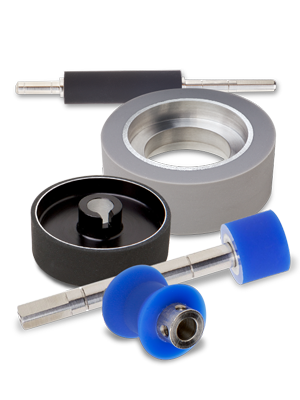The term durometer refers specifically to an object’s hardness measured by its indentation properties, which are defined by an object’s resistance to permanent indentation. Often times the word durometer is referred to as both the measurement of hardness and the durometer instrument which was created by Albert Ferdinand Shore in the 1920s to determine scales of Shore hardness.
While the origins of both hardness scales and the coining of the term durometer trace back a significant number of years before the Shore hardness scale was invented, the vast majority of modern science practices rely on its scales in one form or another.
There are several different types of durometer scales used to properly measure the hardness properties of materials, but the two most common scales are the ASTM D2240 type A and D scales. Scale A is designed to measure the hardness of softer plastic materials, like out urethane rollers which have a durometer hardness of 55 and 70, while Scale D is designed to measure the hardness of harder plastics.
The largest and most interesting difference between Scale A and Scale D originates from the physical size of the hardened steel rod performing the durometer. With the hardened steel rod in Scale A, the foot measures 1.1mm-1.4mm in diameter with a 30°. In Scale D, the hardened steel rod measures the same 1.1mm-1.4mm diameter but differs in that its radius has a narrower tip and has a 30° conical point instead.
The ASTM D2240 recognizes ten other different durometer scales, all differentiating in accordance to the types of material they measure. Some of these difference include diameter, extension, and spring force.
To put things into perspective, the durometer has measured properties of hardness in common objects which you may see or use daily, such as the bicycle seat, chewing gum, rubber band, door seal, skateboard wheels and much more. Each of these materials in ranked in a scale ranging from 0-100, where higher values indicate harder materials and lower values indicate softer materials.
Can you guess which materials ranked where? Check out some of the durometer values below on common objects.
• Bicycle seat: 15-30
• Chewing gum: 20
• Rubber band: 25
• Door seal: 55
• Skateboard wheel: 98
The twelve durometer types are A, C, D, B, M, E, O, OO, DO, OOO, and OOO-S. The bicycle seat and the chewing gum fit within the OO Scale, for example, while the skateboard wheel, rubber band, and door seal fit within the A Scale.
All in all, it’s intriguing to sometimes stop and wonder about how a scale might have been originally constructed to accurately describe the hardness properties of all different types of materials around you. Among even the most modern science ideologies today, the Shore hardness scales are as solidified a concept as some of the hardest objects measured to date.


